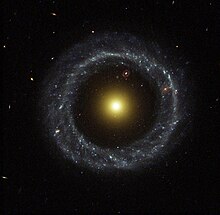
A ring galaxy is a galaxy with a circle-like appearance. Hoag's Object, discovered by Arthur Hoag in 1950, is an example of a ring galaxy.[1] The ring contains many massive, relatively young blue stars, which are extremely bright. The central region contains relatively little luminous matter. Some astronomers believe that ring galaxies are formed when a smaller galaxy passes through the center of a larger galaxy. Because most of a galaxy consists of empty space, this "collision" rarely results in any actual collisions between stars. However, the gravitational disruptions caused by such an event could cause a wave of star formation to move through the larger galaxy.[2] Other astronomers think that rings are formed around some galaxies when external accretion takes place. Star formation would then take place in the accreted material because of the shocks and compressions of the accreted material.[3][4]
- ^ Nemiroff, R.; Bonnell, J., eds. (September 9, 2002). "Hoag's Object: A Strange Ring Galaxy". Astronomy Picture of the Day. NASA. Retrieved March 31, 2012.
- ^ Fernandez, Julia; Alonso, Sol; Mesa, Valeria; Duplancic, Fernanda; Coldwell, Georgina (2021-09-01). "Properties of galaxies with ring structures". Astronomy & Astrophysics. 653: A71. arXiv:2107.06920. doi:10.1051/0004-6361/202141208. ISSN 0004-6361.
- ^ Appleton, P.N.; Struck-Marcell, Curtis (1996). "Collisional Ring Galaxies". Retrieved March 31, 2012.
- ^ "Ring galaxies, the rarest in the Universe, finally explained". Big Think. 2022-04-20. Retrieved 2024-09-13.